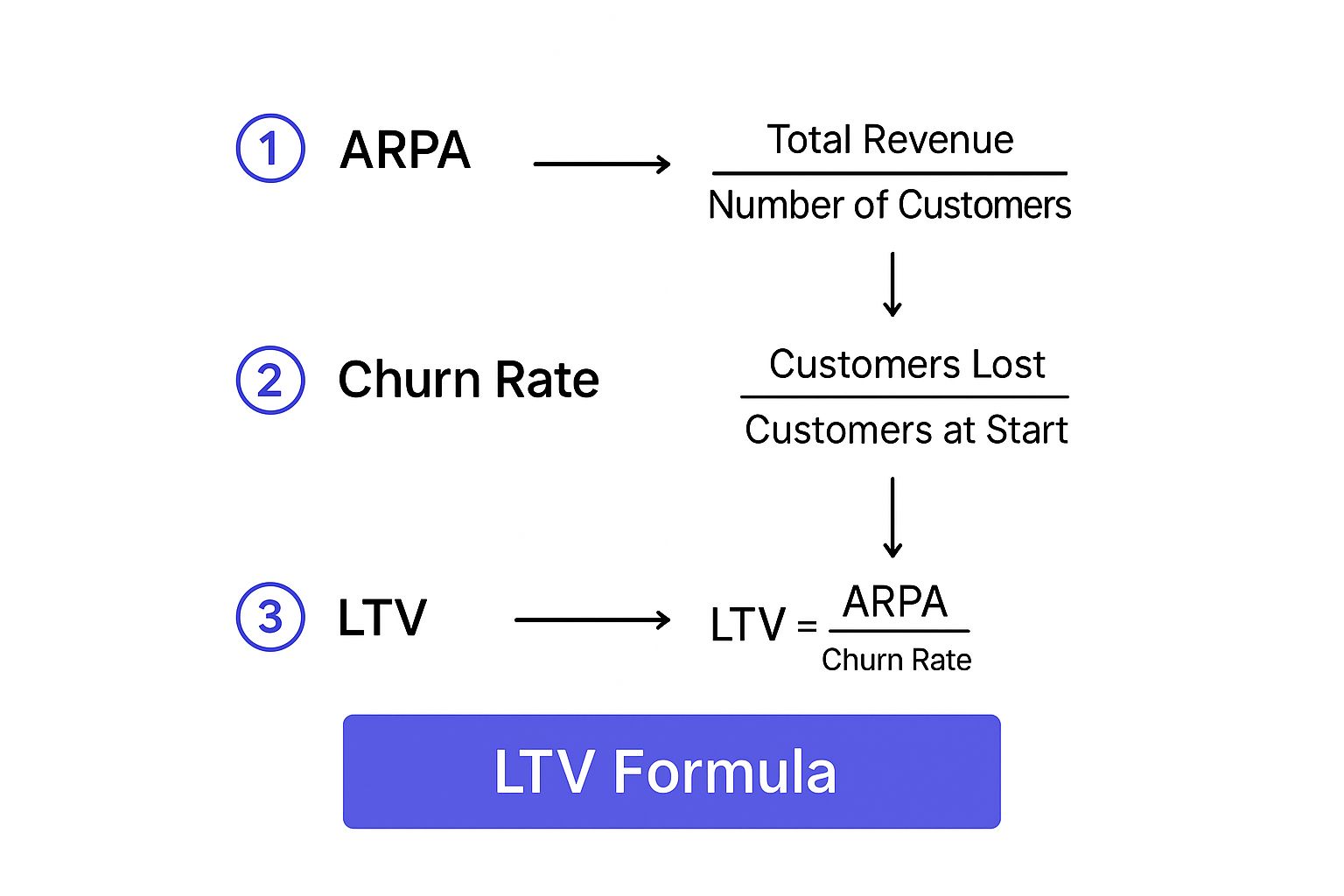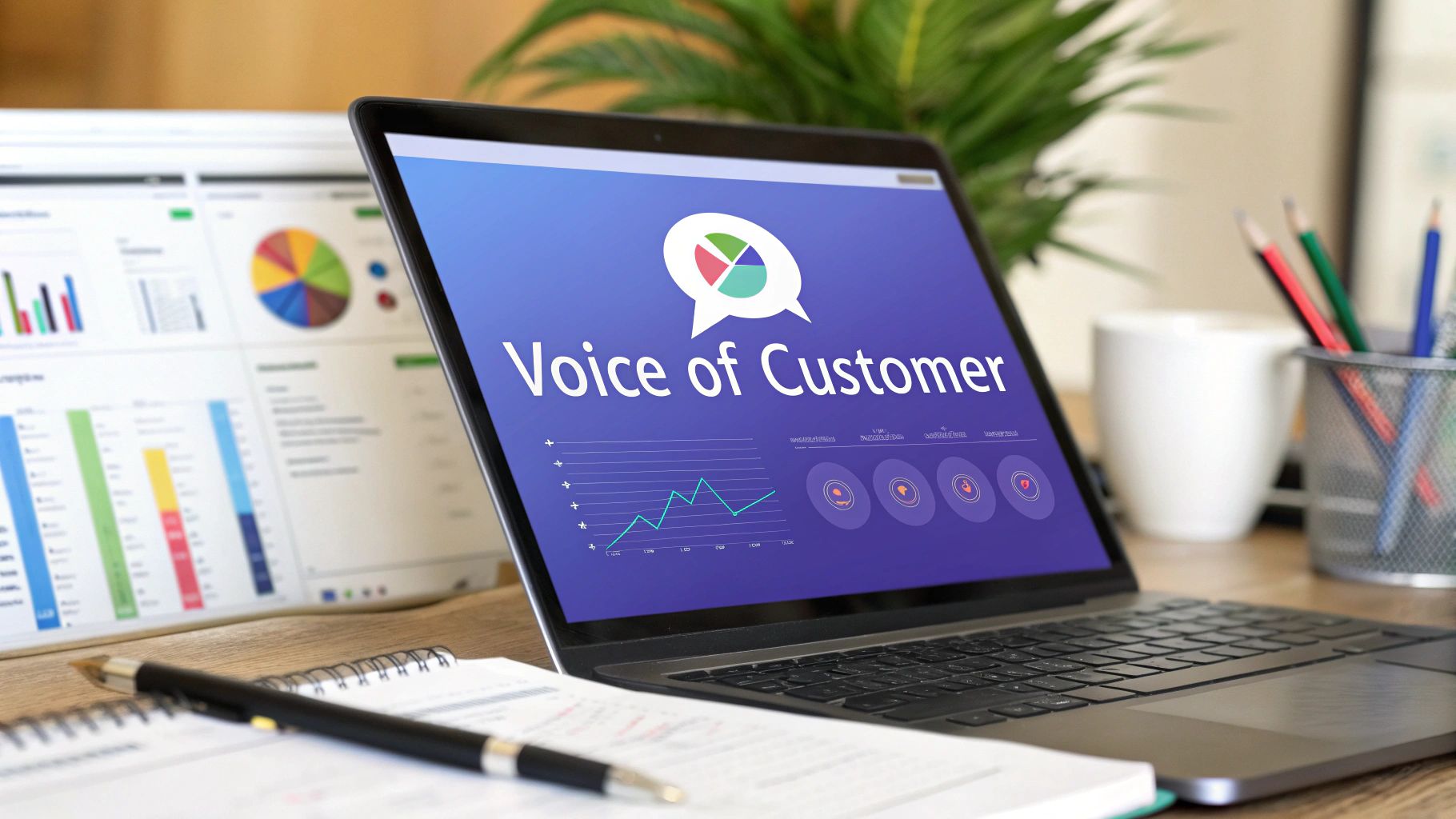Calculating Lifetime Value SaaS for Growth
Learn how to accurately calculate lifetime value SaaS with proven strategies and formulas to boost your business growth. Get started today!

Forget about short-term wins. If you're building a SaaS business that's meant to last, the real secret is understanding Customer Lifetime Value (LTV). This metric tells you the total revenue you can expect from a typical customer over their entire time with you.
Calculating LTV for your SaaS isn't just some boring accounting task; it's the strategic compass that should guide every major decision you make.
Why LTV Is Your SaaS Growth Compass
So many SaaS founders get swept up in the excitement of new sign-ups. And hey, getting new customers is great. But focusing only on acquisition is like trying to fill a leaky bucket—you're constantly pouring water in, but it's seeping out just as fast.
The most durable, profitable SaaS companies I've seen have all made a crucial shift. They move their focus from those fleeting acquisition wins to building real, long-term customer relationships.
This is exactly where LTV becomes your most important guide. It changes the entire conversation from, "How many new users did we get this month?" to a much more powerful question: "How much is each customer actually worth to us over time?" This simple perspective shift has massive implications for your business.
From Vanity Metrics to Strategic Decisions
When you truly get a handle on your LTV, you can start answering critical business questions with real confidence:
- How much can we afford to spend on marketing? Knowing what a customer is worth is the only way to set an intelligent Customer Acquisition Cost (CAC) budget.
- Which customer segments are our best bet? You can pinpoint and double down on acquiring users who stick around longer and spend more.
- Is our pricing right? LTV data might show you that you're seriously underpricing your service for your most loyal, high-value users.
- What product features should we build next? You can invest in features that improve retention and drive expansion revenue, which directly pumps up your LTV.
A focus on LTV forces you to build a better business, period. It incentivizes you to create a product people love and can't imagine their workday without, to improve your customer support, and to build genuine loyalty.
The Foundation of Sustainable Growth
At the end of the day, a strong LTV is what separates the SaaS companies that thrive from those that just scrape by. When customers stay longer, they generate more recurring revenue, give you priceless feedback, and become your best salespeople through referrals. This is how you build a powerful, self-sustaining growth loop.
Behavioral analytics—like how often users log in and which features they adopt—are your crystal ball for predicting LTV. By making your product an essential part of your customers' daily workflow, you make it "sticky" and slash the risk of churn. Your service stops being a line item on an expense report and becomes a vital tool they can't operate without. You can dive deeper into this approach for building a successful SaaS business with LTV on contentsquare.com.
The Building Blocks of an Accurate LTV Calculation

Before you can jump into the full LTV formula, you need to get your ingredients in order. I've seen it time and time again: a flashy LTV number that looks great on a slide but falls apart under scrutiny because the underlying data was shaky.
An accurate LTV is only as good as the numbers you feed it. Think of this as your pre-flight checklist. Getting these core components right from the start ensures your final calculation is not just a number, but a reliable tool for making smart business decisions.
Let's break down the essential metrics that form the foundation of calculating lifetime value for your SaaS. You’ll pull these raw materials from your billing platform, CRM, or financial software.
Average Revenue Per Account (ARPA)
First up is your Average Revenue Per Account, or ARPA. This tells you, on average, how much revenue you're bringing in from each customer account over a specific period—usually a month. It’s a fantastic pulse check on whether your pricing strategy and expansion revenue efforts are hitting the mark.
Calculating it is pretty straightforward: you just divide your total monthly recurring revenue by your number of customers.
- Formula: Total Monthly Recurring Revenue (MRR) / Total Number of Active Accounts
Let's say your SaaS brought in $50,000 in MRR last month from 500 customers. Your ARPA would be a clean $100. This figure gives you a baseline for what a typical account is worth before you factor in how long they stick around.
Customer Churn Rate
Next, we have the metric that keeps every SaaS founder up at night: Customer Churn Rate. This is simply the percentage of your customers who cancel their subscriptions in a given period. It's the ultimate nemesis of growth.
You can have the best customer acquisition machine in the world, but a high churn rate will silently sink your ship. It’s the leak in your bucket.
- Formula: (Number of Customers Who Canceled in Period / Number of Customers at Start of Period) x 100
Imagine you started the month with 500 customers, but 25 of them decided to leave. That gives you a monthly churn rate of 5%. Knowing this "leak rate" is absolutely fundamental to figuring out the "lifetime" part of LTV.
Gross Margin
Finally, and this is the one people often forget, you need your Gross Margin. This metric gets real about profitability by subtracting the direct costs of delivering your service—what we call the Cost of Goods Sold (COGS).
Your LTV calculation must reflect profit, not just revenue. Including Gross Margin separates the truly profitable customers from those who cost a lot to serve, giving you a much truer picture of business health.
In the SaaS world, COGS usually includes things like:
- Hosting and infrastructure costs (like AWS or Azure bills)
- Fees for third-party software or data services you rely on
- Salaries for your customer support and success teams
The formula helps you see what's left after those costs are paid.
- Formula: ((Total Revenue - COGS) / Total Revenue) x 100
If your total revenue is $50,000 and your COGS adds up to $10,000, your Gross Margin is 80%. In other words, for every dollar of revenue, you keep 80 cents as gross profit.
To help you keep these straight, here's a quick summary of the metrics you'll need.
Essential Metrics for LTV Calculation
This table breaks down the core components we just discussed. Think of it as your cheat sheet for gathering the right data before you calculate LTV.
MetricWhat It MeasuresSimple FormulaARPAThe average revenue generated per account, usually monthly.Total MRR / Total Active AccountsChurn RateThe percentage of customers who cancel during a period.(Canceled Customers / Starting Customers) x 100Gross MarginThe profitability of your service after direct costs (COGS).((Revenue - COGS) / Revenue) x 100
Getting a solid handle on each of these metrics is the first and most critical step.
For a deeper dive into the mechanics, Stunning has a great guide on how to calculate Customer Lifetime Value.
With these three building blocks—ARPA, Churn Rate, and Gross Margin—you're ready to go. Our complete guide on how to calculate lifetime value in SaaS will now show you how to combine them into the final, powerful LTV formula.
Choosing Your LTV Calculation Method
When it comes to calculating lifetime value in SaaS, one size definitely doesn't fit all. The formula you settle on has a direct impact on the insights you get, guiding everything from how much you can afford to spend on marketing to what you build next on your product roadmap.
Let's walk through the two most important ways to calculate LTV. We’ll start with a quick and dirty approach and then graduate to a much more precise, profit-focused formula.
To keep things grounded, we'll use a consistent example. Imagine we're running a project management tool called 'SyncUp' with these monthly numbers:
- Average Revenue Per Account (ARPA): $200
- Customer Churn Rate: 4%
- Gross Margin: 75%
With these metrics in hand, we can see how different formulas tell very different stories about our business.
The Quick and Simple LTV Formula
The most straightforward way to get a read on LTV is by dividing your Average Revenue Per Account (ARPA) by your Customer Churn Rate. It’s a back-of-the-napkin calculation, but it’s perfect for getting a fast, directional snapshot of the total revenue you can expect from a customer. I often use it for quick health checks or spotting high-level trends.
Formula: LTV = ARPA / Customer Churn Rate
Let's plug in the numbers for our 'SyncUp' example:
- LTV = $200 / 0.04
- LTV = $5,000
This tells us that, on average, a new 'SyncUp' customer will generate $5,000 in revenue before they churn out. That’s a useful number, but it overlooks a critical piece of the puzzle: profitability. It completely ignores the costs we incur to actually deliver our service.
The infographic below shows how these core metrics flow together to build up the LTV calculation.

As you can see, metrics like revenue and churn are the fundamental building blocks for understanding what a customer is truly worth over time.
The Profit-Driven LTV Formula
If you want a truer picture of customer value—and you absolutely should—you have to factor in your Gross Margin. This adjusted formula calculates the lifetime profit a customer generates, not just the revenue they bring in. It properly accounts for direct costs like hosting, third-party software licenses, and the salaries of your customer support team.
This is the formula you should be using for any critical financial decisions. It separates the high-revenue, high-cost customers from the genuinely profitable ones. This is what stops you from overspending to acquire customers who aren't actually good for your bottom line.
Formula: LTV = (ARPA x Gross Margin %) / Customer Churn Rate
Now, let's recalculate the LTV for 'SyncUp' using this much more robust method:
- LTV = ($200 x 0.75) / 0.04
- LTV = $150 / 0.04
- LTV = $3,750
Look at that difference. The simple formula gave us an LTV of $5,000, but the profit-driven formula shows a more realistic LTV of $3,750.
That $1,250 gap represents the total cost of servicing that customer over their entire lifecycle. Ignoring that cost is a classic mistake that leads founders to disastrously overvalue their customers and set completely unsustainable marketing budgets. When you're making strategic plans, always, always use the profit-based calculation.
Making Sense of Your LTV to CAC Ratio
Knowing your LTV is great, but that number on its own is only half the story. To really get a pulse on the health and scalability of your SaaS business, you need to put it up against your Customer Acquisition Cost (CAC).
The LTV to CAC ratio is where the rubber meets the road. It transforms LTV from just another metric into a powerful diagnostic tool for your entire growth strategy.
This ratio cuts straight to the most critical question every founder and marketer has: "Are we spending our acquisition budget wisely?" It tells you exactly how much lifetime value you squeeze out of every single dollar you put into sales and marketing. Of course, to get this right, you first need a solid grip on your acquisition costs. If you need a refresher, this is a great guide to calculate Customer Acquisition Cost for B2B.
Interpreting Your LTV to CAC Ratio
Think of this ratio as a quick health check for your business model. The number you get isn't just a number—it’s a signal telling you what to do next.
Here’s a practical breakdown of what your LTV:CAC ratio is really telling you:
- 1:1 Ratio: This is a five-alarm fire. It means for every dollar you spend to get a customer, you only get one dollar back over their entire time with you. Factor in your operational costs, and you're actively losing money on every new sign-up. This model just won't last.
- 3:1 Ratio: Now we're talking. This is widely seen as the sweet spot for a healthy, scalable SaaS company. You're generating $3 in value for every $1 you spend on acquisition. This shows you've built a solid business model with enough margin to cover all your costs, reinvest in growth, and actually make a profit.
- 5:1+ Ratio: This looks amazing on paper, but it might be a sign that you're playing it too safe. An incredibly efficient acquisition engine like this means you could probably be spending more aggressively on sales and marketing to grab market share much faster without putting your profitability at risk.
A healthy SaaS LTV:CAC ratio is generally considered to be around 3:1 or higher, meaning a customer's lifetime value should be at least triple the cost of acquiring them. For instance, the Adtech sector boasts a robust 7:1 LTV:CAC ratio, with an average LTV of $6,800 versus a $956 CAC, indicating highly efficient acquisition. Meanwhile, sectors like cybersecurity, edtech, and fintech often maintain solid ratios between 4:1 and 6:1, showing that maintaining an ideal balance is key to sustainable scaling. You can explore more about these SaaS industry benchmarks on eqvista.com.
At the end of the day, this ratio gives you the context you need to make smart, data-backed decisions. It helps you justify your marketing budget, pinpoint your most profitable channels, and know exactly when it’s time to hit the accelerator versus when to pull back and optimize.
Actionable Strategies to Boost Your SaaS LTV

Alright, so you’ve crunched the numbers and have a solid grasp of your LTV. That’s the baseline. Now comes the fun part: making that number grow. This is where you roll up your sleeves and turn metrics into momentum.
Boosting your LTV isn't some dark art. It really boils down to excelling in a few key areas that create a more durable, profitable business. You need to get better at keeping customers around, find smart ways to increase what they spend, and deliver an experience that makes them want to stick with you for the long haul.
Once you have your LTV calculated, the next move is to put strategies in place to nudge it upwards. For a deeper dive, you can explore these proven strategies to increase customer lifetime value.
Fortify Your Defenses By Reducing Churn
The most straightforward path to a higher LTV? Stop the leaks. When you get customers to stay longer, every other effort you make has more time to compound and deliver results. A lower churn rate automatically extends the average customer lifespan, which is the foundation of a healthy LTV.
This is where proactive customer success becomes your most valuable player. Don’t just sit back and wait for the dreaded cancellation email. Dive into your product usage data to spot at-risk accounts before they decide to leave. Is a team suddenly ignoring a feature they used to love? That’s a huge red flag. A quick, helpful email with a tip or an offer for a brief training session can be all it takes to get them re-engaged.
A smooth onboarding process is also completely non-negotiable. Those first few weeks are your golden window to prove your product's worth. Guide new users straight to their "aha!" moment with things like in-app tutorials, simple checklists, and personalized welcome messages. That initial win builds the momentum you need to carry them forward. For more on this, check out our guide on effective customer retention strategies.
Increase Revenue From Your Existing Base
Let’s be honest: acquiring new customers is a grind, and it's expensive. It’s far more efficient to grow the revenue you get from the customers you’ve already won over. This is all about increasing your Average Revenue Per Account (ARPA).
Start by looking at your pricing tiers. Do they truly align with the value you deliver? A smart play here is to tie your tiers to tangible outcomes. For example, a basic plan might offer standard reporting, but a premium plan could unlock predictive analytics. This creates a natural, value-driven upgrade path as your customers’ needs mature.
And don’t forget the power of intelligent cross-selling. If you have multiple products or slick add-ons, find the perfect moment to introduce them. A project management tool, for instance, could offer an optional time-tracking module to teams that are consistently handling more complex projects. It’s about offering the right solution at the right time.
While 89% of companies agree that a great customer experience and CLV are crucial for loyalty, accurately measuring it remains a hurdle. Recent 2025 data reveals that only 42% of firms can track CLV properly, yet the rewards for doing so are immense.
A mere 5% boost in customer retention can increase profitability by 25% to 95%. This is why marketers who monitor CLV closely see a 40% rise in sales from targeted upsells, which contribute to 31% of total revenue.
Build Loyalty Through a Superior Experience
Finally, never, ever underestimate the power of a genuinely great customer experience. This is so much more than just fixing bugs or closing support tickets. It’s about making your customers feel heard, valued, and understood at every single touchpoint.
Here are a few ways to really elevate that experience:
- Act on Feedback: Don't just collect survey responses and let them gather dust. When a customer gives you a suggestion, act on it. Then, close the loop and let them know you listened. It’s incredibly powerful.
- Create a Community: Build a user forum or community where your customers can connect, share best practices, and help each other out. This creates a valuable network effect around your product that money can't buy.
- Personalize Communication: Use the data you have to send relevant, genuinely helpful content. Ditch the generic marketing blasts and speak to your customers like you actually know them.
Actions like these build the kind of deep-seated loyalty that makes customers stick around, spend more, and, best of all, tell their friends. This is how you transform your customer base from a simple revenue stream into a powerful growth engine for your business.
Common Questions About SaaS LTV Calculation
Even with all the formulas laid out, I've found that some practical questions always come up once teams start getting their hands dirty with lifetime value. The theory is one thing, but the real world has nuances. Getting clear on these common sticking points will help you sidestep some painful mistakes and actually use LTV effectively.
Let's walk through some of the most frequent questions I hear on the journey to mastering LTV.
How Often Should I Calculate LTV?
For most SaaS businesses, aiming for a monthly or quarterly calculation strikes the perfect balance. Monthly check-ins are fantastic for spotting new trends early. You can react quickly if your average revenue dips or your churn rate ticks up. It’s like keeping a finger on the pulse of your business health.
A quarterly review, on the other hand, gives you a more stable, big-picture view. It smooths out any of the short-term statistical noise that can be distracting. This cadence is incredibly useful for high-level strategic planning, investor updates, and board meetings. Whatever you do, avoid calculating it too often, like weekly. Minor fluctuations rarely signal a real change in your business's trajectory and can just lead to panic over nothing.
What Is a Common Mistake When Calculating SaaS LTV?
The single most common—and costly—mistake I see is forgetting to factor in the Gross Margin. So many teams stop at the simple formula (ARPA / Churn Rate), but that only gives you lifetime revenue, not lifetime profit.
A high-revenue, low-margin customer might look great on paper but could be less valuable to your business than a lower-revenue, high-margin one. Always use the Gross Margin-adjusted formula for making important financial and strategic decisions to get a true picture of profitability.
This one oversight can lead to dangerously inflated LTV figures. It tricks you into overspending on customer acquisition and completely misjudging the health of your unit economics. Your LTV absolutely must reflect the actual profit left over after the direct costs of serving your customers.
How Does LTV Differ for B2B vs B2C SaaS?
While the core concept is the same, the dynamics and the resulting numbers for B2B and B2C SaaS are worlds apart. It’s absolutely crucial to understand these differences when you're setting benchmarks and building out your growth strategies.
Here’s a quick breakdown of what I typically see:
- B2B SaaS: Almost always has a much higher LTV per customer. This is driven by bigger contract values, much stickier customers (thanks to high switching costs), and huge potential for expansion revenue through upsells for more seats or advanced features.
- B2C SaaS: Often operates with a lower LTV per customer. These models usually have higher churn and have to focus on acquiring a massive volume of users to make the economics work.
This distinction directly shapes how you approach growth. The strategies you use to grow LTV will look very different—B2B will lean heavily on dedicated account management, while B2C will focus more on broad, mass-market engagement. If you're looking for more ways to grow this number, our guide covers several practical methods for how to increase customer lifetime value.
Ready to turn feedback into growth? Surva.ai gives you the AI-powered tools to understand why customers churn and how to keep them. Start reducing churn and boosting your LTV today at https://www.surva.ai.


